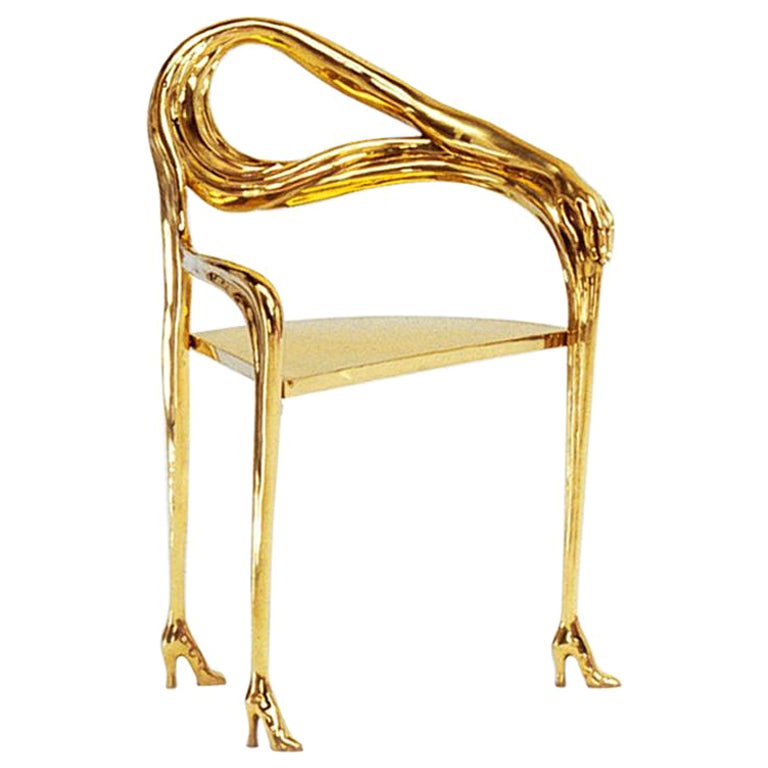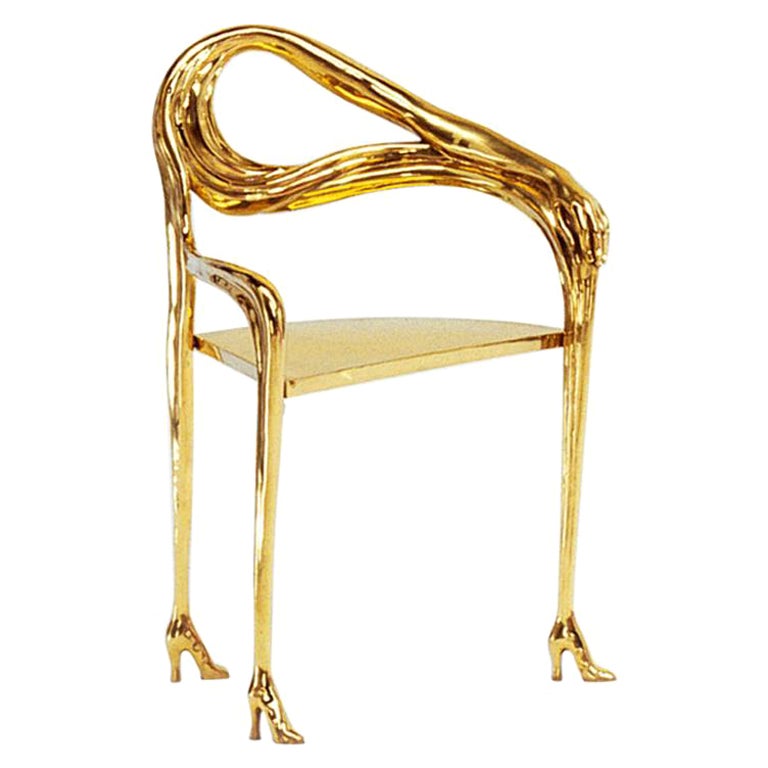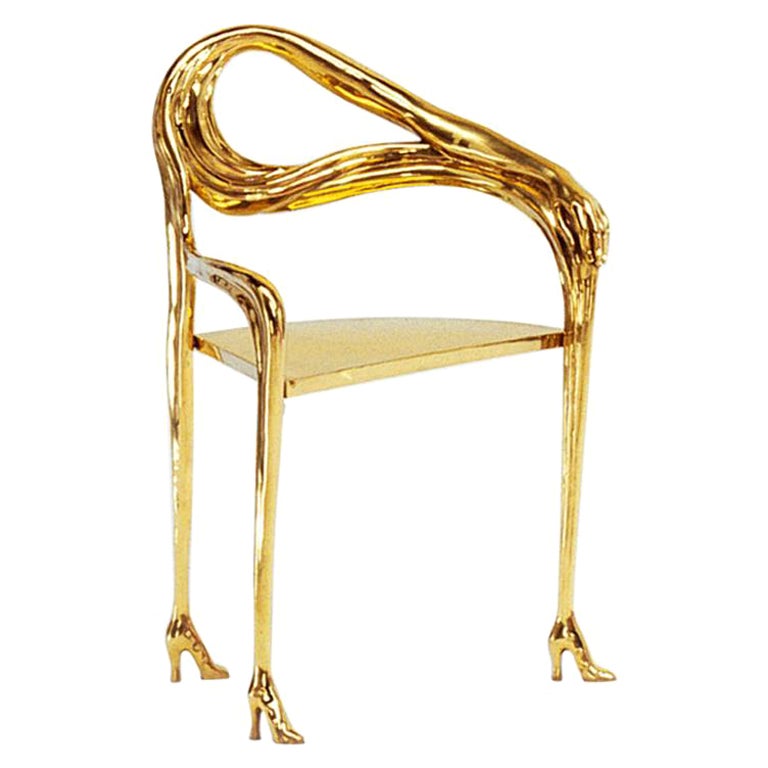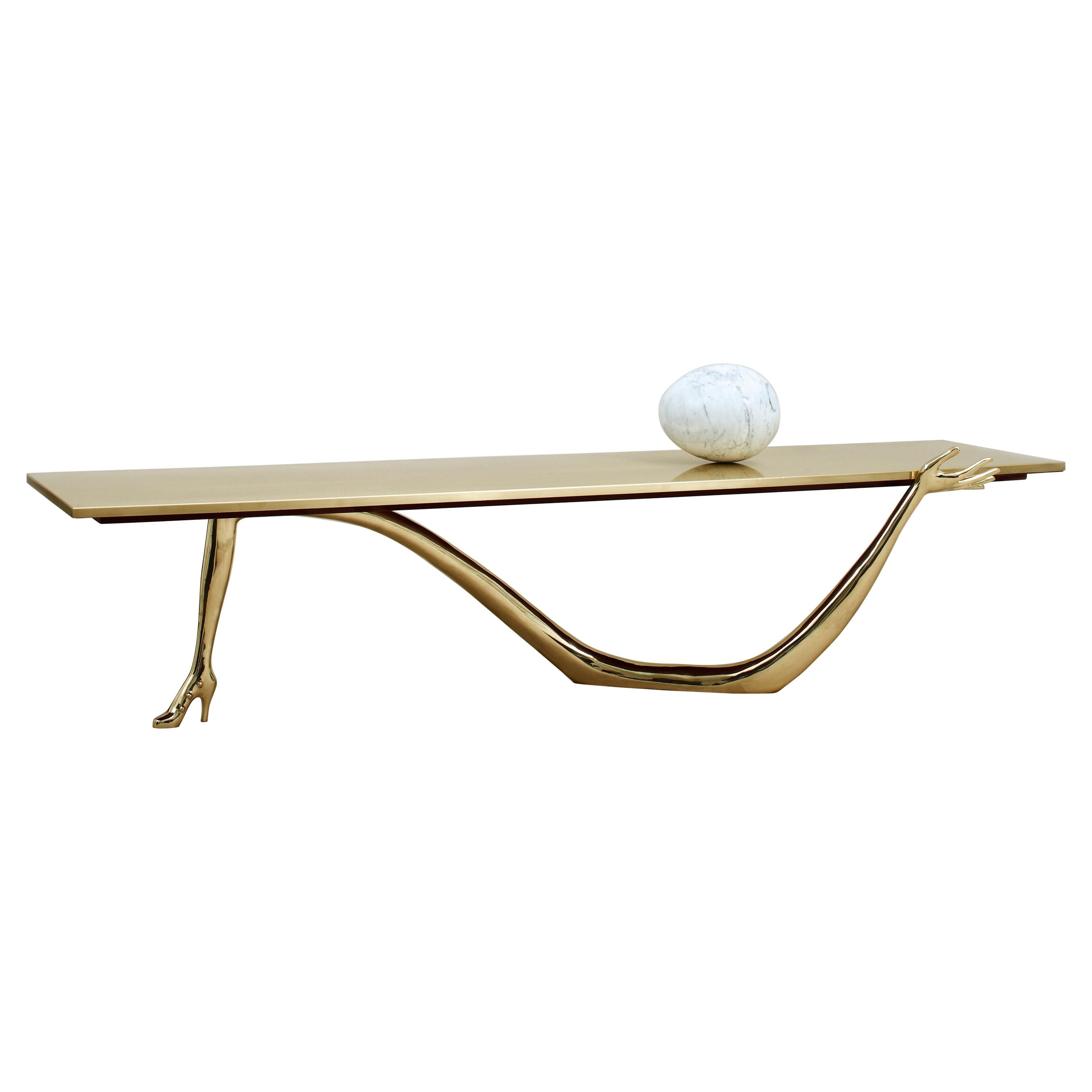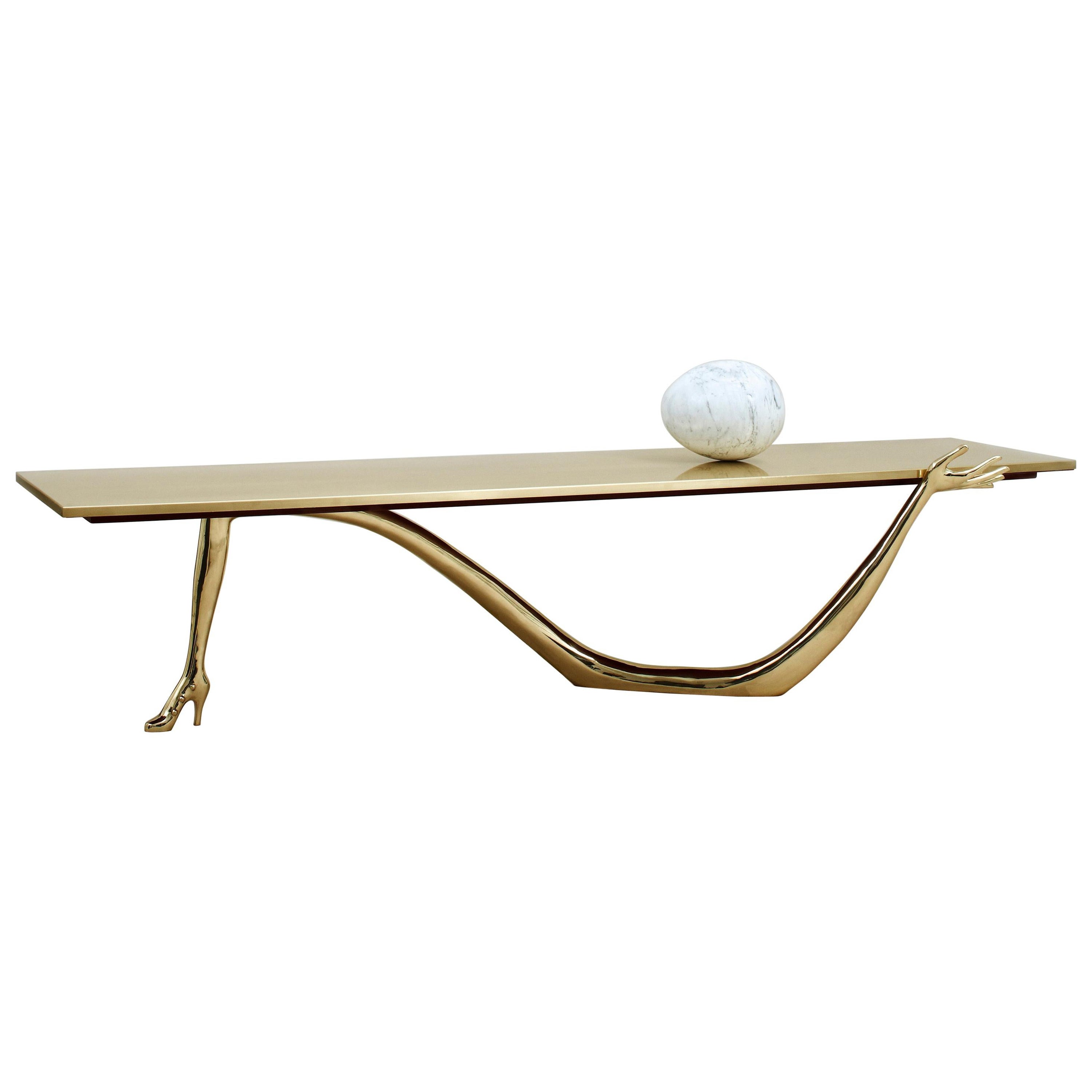Brass chair model "Leda" by Salvador Dalí surrealist design
About the Item
- Creator:Salvador Dalí (Designer),BD Barcelona Design (Manufacturer)
- Dimensions:Height: 36.23 in (92 cm)Width: 23.63 in (60 cm)Depth: 18.51 in (47 cm)
- Style:Modern (In the Style Of)
- Materials and Techniques:Brass,Polished
- Place of Origin:
- Period:
- Date of Manufacture:2023
- Production Type:New & Custom(Current Production)
- Estimated Production Time:9-10 weeks
- Condition:
- Seller Location:Barcelona, ES
- Reference Number:1stDibs: LU3048332559672
Salvador Dalí
Instantly recognizable by his waxed, upturned mustache, the flamboyant Salvador Dalí is one of modern art’s most distinctive figures. He is also one of the icons of the 20-century avant-garde Surrealist movement, whose dreamlike images, drawn from the depths of the unconscious, he deployed in paintings, sculptures, prints and fashion, as well as in film collaborations with Luis Buñuel and Alfred Hitchcock.
Dalí was born in Figueres, Catalonia, and even as a youngster, displayed the sensitivity, sharp perception and vivid imagination that would later define his artworks. In these, he conjured childhood memories and employed religious symbols and Freudian imagery like staircases, keys and dripping candles to create unexpected, often shocking pieces.
Dalí's use of hyperrealism in conveying Surrealist symbols and concepts that subvert accepted notions of reality is epitomized in what is perhaps his most recognizable painting, The Persistence of Memory (1931), in which he depicts the fluidity of time through melting clocks, their forms inspired by Camembert cheese melting in the sun. His artistic genius, eccentric personality and eternal quest for fame made him a global celebrity.
“Each morning when I awake, I experience again a supreme pleasure,” he once said. “That of being Salvador Dalí.”
Find original Salvador Dalí paintings, prints, sculptures and other works on 1stDibs.
- ShippingRetrieving quote...Ships From: BARCELONA, Spain
- Return PolicyA return for this item may be initiated within 2 days of delivery.
- Armchair model "Leda" By Salvador Dalí Spanish surrealist 20th century designBy Salvador Dalí, BD Barcelona DesignLocated in Barcelona, ESArmchair model "Leda" Structure in polished cast brass varnish. Salvador Dali Taken from “Femme à tête de roses" (1935)” 1935 (Woman with a head of roses). It was sufficient for this sculpture to be made as a three dimensional piece, remaining faithful to every detail in Dalí’s painting. Dalí affirmed: “A chair can be used even to sit on, but only on one condition: That we sit uncomfortably.” We can sit on the Leda, but due to the fact that it only has three legs and that the chair is heavy, it being made of solid brass, is more a work of art than a functional piece of furniture. © Salvador Dalí, Fundació Gala-Salvador Dalí, Figueres, 2022 Artworks by Salvador Dalí: © Salvador Dalí, Fundació Gala-Salvador Dalí, VEGAP, Barcelona, 2022 Salvador Dalí is the most versatile and prolific artists of the 20th century and the most famous Surrealist. Though chiefly remembered for his painterly output, in the course of his long career he successfully turned to sculpture, printmaking, fashion, advertising, writing, filmmaking and design. Born in Figueres, Catalonia, Dalí received his formal education in fine arts in Madrid. Influenced by Impressionism and the Renaissance masters from a young age, he became increasingly attracted to Cubism and avant-garde movements. He moved closer to Surrealism in the late 1920s and joined the Surrealist group in 1929, soon becoming one of its leading exponents. In the Paris of the 1930s, Dalí surrounded himself with a circle of friends working in the application of art to a number of varied disciplines, beyond the study of purely pictorial art. One of these, Jean-Michel Frank, an acclaimed furniture designer and decorator in Paris at that time, got on extremely well with Dalí, and together they developed a number of ideas. One example of this is the Bracelli lamp, a classic design in Jean-Michel’s manner of designing and working that Dalí adopted for his home in Portlligat. Among Dalí’s projects, which add to his CV as a designer, are the garden furniture for his home in Portlligat, the complete architecture of the Night Club (in the shape of a hedgehog) for the Hotel Presidente in Acapulco (1957) and a project for a bar in California in the 1940s. His creations were not limited to traditional furniture elements, but included taps, handles, knobs, prints and objects of indeterminate use. In 1933, Dalí even registered the patent for the design of a bench as an outdoor seat. In the 1990s, a team of experts led by Oscar Tusquets set out to bring to life the furniture that Dalí had sketched for Jean-Michel Frank, including the Leda chair and low table taken from the 1935 painting “Femme...Category
21st Century and Contemporary Spanish Modern Armchairs
MaterialsBrass
- Brass armchair model "Leda" By Salvador Dalí 20th Century Spanish designBy Salvador Dalí, BD Barcelona DesignLocated in Barcelona, ESArmchair model "Leda" Structure in polished cast brass varnish. Salvador Dali Taken from “Femme à tête de roses" (1935)” 1935 (Woman with a head of roses). It was sufficient for this sculpture to be made as a three dimensional piece, remaining faithful to every detail in Dalí’s painting. Dalí affirmed: “A chair can be used even to sit on, but only on one condition: That we sit uncomfortably.” We can sit on the Leda, but due to the fact that it only has three legs and that the chair is heavy, it being made of solid brass, is more a work of art than a functional piece of furniture. © Salvador Dalí, Fundació Gala-Salvador Dalí, Figueres, 2022 Artworks by Salvador Dalí: © Salvador Dalí, Fundació Gala-Salvador Dalí, VEGAP, Barcelona, 2022 Salvador Dalí is the most versatile and prolific artists of the 20th century and the most famous Surrealist. Though chiefly remembered for his painterly output, in the course of his long career he successfully turned to sculpture, printmaking, fashion, advertising, writing, filmmaking and design. Born in Figueres, Catalonia, Dalí received his formal education in fine arts in Madrid. Influenced by Impressionism and the Renaissance masters from a young age, he became increasingly attracted to Cubism and avant-garde movements. He moved closer to Surrealism in the late 1920s and joined the Surrealist group in 1929, soon becoming one of its leading exponents. In the Paris of the 1930s, Dalí surrounded himself with a circle of friends working in the application of art to a number of varied disciplines, beyond the study of purely pictorial art. One of these, Jean-Michel Frank, an acclaimed furniture designer and decorator in Paris at that time, got on extremely well with Dalí, and together they developed a number of ideas. One example of this is the Bracelli lamp, a classic design in Jean-Michel’s manner of designing and working that Dalí adopted for his home in Portlligat. Among Dalí’s projects, which add to his CV as a designer, are the garden furniture for his home in Portlligat, the complete architecture of the Night Club (in the shape of a hedgehog) for the Hotel Presidente in Acapulco (1957) and a project for a bar in California in the 1940s. His creations were not limited to traditional furniture elements, but included taps, handles, knobs, prints and objects of indeterminate use. In 1933, Dalí even registered the patent for the design of a bench as an outdoor seat. In the 1990s, a team of experts led by Oscar Tusquets set out to bring to life the furniture that Dalí had sketched for Jean-Michel Frank, including the Leda chair and low table taken from the 1935 painting “Femme...Category
21st Century and Contemporary Spanish Modern Armchairs
MaterialsBrass
- "Leda" Armchair Sculpture by Salvador Dalí 20th Century Surrealist designBy Salvador Dalí, BD Barcelona DesignLocated in Barcelona, ESArmchair model "Leda" Structure in polished cast brass varnish. Salvador Dali Taken from “Femme à tête de roses" (1935)” 1935 (Woman with a head of roses). It was sufficient for this sculpture to be made as a three dimensional piece, remaining faithful to every detail in Dalí’s painting. Dalí affirmed: “A chair can be used even to sit on, but only on one condition: That we sit uncomfortably.” We can sit on the Leda, but due to the fact that it only has three legs and that the chair is heavy, it being made of solid brass, is more a work of art than a functional piece of furniture. © Salvador Dalí, Fundació Gala-Salvador Dalí, Figueres, 2022 Artworks by Salvador Dalí: © Salvador Dalí, Fundació Gala-Salvador Dalí, VEGAP, Barcelona, 2022 Salvador Dalí is the most versatile and prolific artists of the 20th century and the most famous Surrealist. Though chiefly remembered for his painterly output, in the course of his long career he successfully turned to sculpture, printmaking, fashion, advertising, writing, filmmaking and design. Born in Figueres, Catalonia, Dalí received his formal education in fine arts in Madrid. Influenced by Impressionism and the Renaissance masters from a young age, he became increasingly attracted to Cubism and avant-garde movements. He moved closer to Surrealism in the late 1920s and joined the Surrealist group in 1929, soon becoming one of its leading exponents. In the Paris of the 1930s, Dalí surrounded himself with a circle of friends working in the application of art to a number of varied disciplines, beyond the study of purely pictorial art. One of these, Jean-Michel Frank, an acclaimed furniture designer and decorator in Paris at that time, got on extremely well with Dalí, and together they developed a number of ideas. One example of this is the Bracelli lamp, a classic design in Jean-Michel’s manner of designing and working that Dalí adopted for his home in Portlligat. Among Dalí’s projects, which add to his CV as a designer, are the garden furniture for his home in Portlligat, the complete architecture of the Night Club (in the shape of a hedgehog) for the Hotel Presidente in Acapulco (1957) and a project for a bar in California in the 1940s. His creations were not limited to traditional furniture elements, but included taps, handles, knobs, prints and objects of indeterminate use. In 1933, Dalí even registered the patent for the design of a bench as an outdoor seat. In the 1990s, a team of experts led by Oscar Tusquets set out to bring to life the furniture that Dalí had sketched for Jean-Michel Frank, including the Leda chair and low table taken from the 1935 painting “Femme...Category
21st Century and Contemporary Spanish Modern Armchairs
MaterialsBrass
- Low brass table model "Leda" by Salvador Dalí spanish surrealist designBy Salvador Dalí, BD Barcelona DesignLocated in Barcelona, ESCoffee table Spain, 1935/37 DIMENSIONS: Table: 1900x451xh.420mm; Table with egg: 1900x451xh.610mm Legs in a cast varnish brass. Table top in brushed and varnished brass. Carrara marble egg on top. Taken from “Femme à tête de roses" (1935)” 1935 (Woman with a head of roses). It was sufficient for this sculpture to be made as a three dimensional piece, remaining faithful to every detail in Dalí’s painting. During the 1930s in Paris, Salvador Dalí surrounded himself with a circle of friends involved in the application of art to varied disciplines, above and beyond the study of pure pictorial art. Jean-Michel Frank, a furniture maker and decorator of recognized prestige in the Paris of those years, was on very good terms with Dalí and together they worked on several ideas. The Bracelli lamp which we present here is a classic design after Jean-Michel’s manner of designing and working, adopted by Dalí for his house at Portlligat. Amongst Dalí ’s specific furnishing projects, and constituting another for his curriculum vitae as a designer, may be counted the garden furnishings for his Portlligat house, the complete architecture of the Night Club (garotte-shaped) for the Hotel Presidente in Acapulco (1957) and another project for a bar in California in the ‘forties. As shown by the small selection now produced and included in this catalogue, Dalí ’s work was not restricted to the traditional furnishing elements, but included tap fittings, handles, door-pulls, printed fabrics and objets of indeterminate use. In the 1990s a group of experts, led by Oscar Tusquets, set themselves the task of turning the furniture Dalí had drawn for Jean-Michel Frank into reality. Amongst these items were the Leda chair...Category
21st Century and Contemporary Spanish Modern Tables
MaterialsBrass
- Brass coffee table model "Leda" by Salvador Dalí 20th Century surrealist designBy Salvador Dalí, BD Barcelona DesignLocated in Barcelona, ESDuring the ‘thirties in Paris, Salvador Dalí surrounded himself with a circle of friends involved in the application of art to varied disciplines, above and beyond the study of pure pictorial art. Jean-Michel Frank, a furniture maker and decorator of recognized prestige in the Paris of those years, was on very good terms with Dalí and together they worked on several ideas. The Bracelli lamp which we present here is a classic design after Jean-Michel’s manner of designing and working, adopted by Dalí for his house at Portlligat. Amongst Dalí ’s specific furnishing projects, and constituting another for his curriculum vitae as a designer, may be counted the garden furnishings for his Portlligat house, the complete architecture of the Night Club (garotte-shaped) for the Hotel Presidente in Acapulco (1957) and another project for a bar in California in the ‘forties. As shown by the small selection now produced and included in this catalogue, Dalí ’s work was not restrictes to the traditional furnishing elements, but included tap fittings, handles, door-pulls, printed fabrics and objets of indeterminate use. In the 1990s a group of experts, led by Oscar Tusquets, set themselves the task of turning the furniture Dalí had drawn for Jean-Michel Frank into reality. Amongst these items were the Leda chair...Category
21st Century and Contemporary Spanish Modern Tables
MaterialsBrass
- 20th Century Spanish Surrealist brass "Leda" coffee table by Salvador DalíBy Salvador Dalí, BD Barcelona DesignLocated in Barcelona, ESCoffee table Spain, 1935/37 DIMENSIONS: Table: 1900x451xh.420mm; Table with egg: 1900x451xh.610mm Legs in a cast varnish brass. Table top in brushed and varnished brass. Carrara marble egg on top. Taken from “Femme à tête de roses" (1935)” 1935 (Woman with a head of roses). It was sufficient for this sculpture to be made as a three dimensional piece, remaining faithful to every detail in Dalí’s painting. During the 1930s in Paris, Salvador Dalí surrounded himself with a circle of friends involved in the application of art to varied disciplines, above and beyond the study of pure pictorial art. Jean-Michel Frank, a furniture maker and decorator of recognized prestige in the Paris of those years, was on very good terms with Dalí and together they worked on several ideas. The Bracelli lamp which we present here is a classic design after Jean-Michel’s manner of designing and working, adopted by Dalí for his house at Portlligat. Amongst Dalí ’s specific furnishing projects, and constituting another for his curriculum vitae as a designer, may be counted the garden furnishings for his Portlligat house, the complete architecture of the Night Club (garotte-shaped) for the Hotel Presidente in Acapulco (1957) and another project for a bar in California in the ‘forties. As shown by the small selection now produced and included in this catalogue, Dalí ’s work was not restricted to the traditional furnishing elements, but included tap fittings, handles, door-pulls, printed fabrics and objets of indeterminate use. In the 1990s a group of experts, led by Oscar Tusquets, set themselves the task of turning the furniture Dalí had drawn for Jean-Michel Frank into reality. Amongst these items were the Leda chair...Category
21st Century and Contemporary Spanish Modern Tables
MaterialsBrass
- 2 American Mid-Century Brass Model Of Ship By Curtis JereBy Curtis JeréLocated in New York, NY2 American Mid-Century sculptures of a brass model of a large sailboat standing on a 2 T post stands (by CURTIS JERE) (PRICED EACH)Category
Mid-20th Century North American Mid-Century Modern Sculptures and Carvings
- Pair of Chinese Ming Dynasty Tomb Funeral Pottery Chair ModelsLocated in Atlanta, GAA pair of Chinese stoneware horseshoe cross chairs circa Ming dynasty (15th-17th century). The miniature models were traditionally made as burial offeri...Category
Antique 16th Century Chinese Ming Ceramics
MaterialsStoneware
- Dali Kingdom, 10/11thc, Is a Fierce Buddhist Deity Cast in IronLocated in Ukiah, CAThis is a fierce Buddhist deity cast in iron. Probably from the Dali Kingdom, 10/11thC South of China. Possibly early Tibetan. Solid cast. Condition as shown in photos- generally good, with an ancient iron patina that grows out of the metal. He is missing one hand. He emanates a powerful presence. Currently, he is securely attached to an old plexiglass stands. He is a very good size at 10 inches tall, by 4.5 wide inches by 3.5 inches deep. As he is solid-cast, he is quite heavy. He is holding a skull full of brains in his left hand and has a snake around his neck. He is naked except for a full garland of human heads around his body. Unsure what the 3 prong head-piece is composed of- Nagas? Will be in January auction on live auctioneersCategory
Antique 15th Century and Earlier Sculptures and Carvings
MaterialsIron
- Asian Ching Dynasty Temple ModelLocated in Los Angeles, CAVery rare Asian ching dynasty temple model. Add some History to your interiors with this classical Asian accessory .Category
Early 20th Century Chinoiserie Sculptures and Carvings
MaterialsWood
- Vintage European Lithograph “Portrait of my Dead Brother” by Salvador DaliBy Salvador DalíLocated in San Diego, CASalvador created the Portrait of my Dead Brother painting in 1963 to pay homage to his late brother. His brother had died at the age of three after suffering from an infectious stomach inflammation. As a result, Salvador's parents had named him after his dead brother in a bid fill the void his death had caused. This beautiful high quality and European lithograph...Category
Vintage 1980s French Post-Modern Prints
MaterialsPaper
- Tessellated Stone Pedestal with Brass Accents by Maitland SmithLocated in Delray Beach, FLTessellated stone pedestal with brass accents by Maitland Smith, circa 1970s. Beautiful piece in good condition ,The piece was made in the Philippines and can be used as a pedestal...Category
Vintage 1960s Philippine Pedestals and Columns
MaterialsStone, Brass
